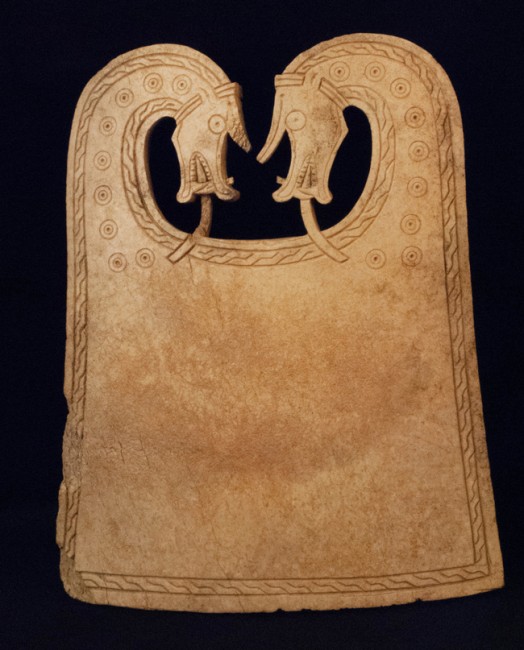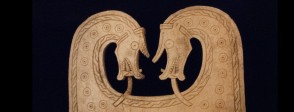
The plaque is flat, carved from one piece of whalebone. At the top it has been carved into the shape of two dragons facing each other with details added on one side of the plaque. It is also decorated with dotted circles and geometric designs.
The burial
The plaque was found in a Viking burial, which was partly uncovered by coastal erosion on the coast near the farm of Scar, and was excavated by archaeologists in 1991. This was a boat burial: a small rowing boat sunk into a pit. At the centre lay the remains of a woman in her seventies with the whalebone plaque and other grave goods including brooches, spindle whorls, an iron sickle and shears. Similar plaques have been found in other rich women’s graves, mostly in northern Norway. Occasional examples are known from Denmark, Sweden and parts of Ireland where Vikings settled.
Lying next to the woman were the remains of a child of about ten years of age. At the western end of the boat lay the skeleton of a man in his thirties, legs bent and arms folded, with a sword, arrows, a bone and antler comb and whalebone gaming pieces.
What was the plaque for?
The function of these whalebone plaques is uncertain. One theory is that they were used like ironing-boards for smoothing folds and seams in linen clothing, with the aid of a smoother, rounded on top with a flat base. A glass object, thought to be such a smoother, has been found in the Orkney Islands - see below in More information. Plaques and smoothing stones are not always found together; but both were found amongst many goods in a woman’s grave in Birka, Sweden.
Another view is that, rather than being used to make clothes look neatly pressed, plaques and smoothers were used in the manufacture of textiles. The shears and spindle whorls found in the burial at Scar were certainly used for textile production, so it is possible that the plaque was placed in the grave with them because the woman used it for the same purpose.
Recently, some archaeologists have suggested that whalebone plaques were serving-platters for food at high status feasts, since cutting and chopping marks have been found on some examples. No such marks are visible on the plaque found at Scar, but its fine decoration would have looked impressive on the table at a feast.
Whalebone plaques may have also had a symbolic function. Whalebone was a prized material, obtained through risky hunting operations or if whales became stranded or washed ashore. The plaques appear to be linked with women, as women have been buried with them and so perhaps used them in life. Because of this it has been suggested that whalebone plaques symbolised the central role Viking women played in the home: organising the household, caring for the family, preparing food and making clothing.
Who were the people in the burial?
Analysis of the grains of sand found in the caulking used to seal the boat revealed particles of igneous rock unlike that found on the island and more often found in Norway. This suggests that the boat was built in Norway and transported to Orkney on a larger boat; perhaps the people buried in it were from Norway too. The rich grave goods suggest that the people in the burial were wealthy, but it is not clear whether they were related. It has been suggested that the man, squashed into a corner of the boat, was the woman’s servant, but the finds with him suggest otherwise. The skeletons were incomplete due to erosion and animal disturbance. Analysis of the bones indicated that the woman died in her seventies, which was unusually old. It is not impossible that the woman, man and child represent three generations of the same family; but what caused them to die and be buried together is not known.
More information
Burial excavation
A short summary of the excavation of the burial that contained the plaque, with photos taken by archaeologists, followed by more detailed archaeological notes.
http://canmore.rcahms.gov.uk/en/site/3494/details/sanday+quoy+banks/
Discovering the burial
The story of the discovery of the burial the plaque was found in summarised on the BBC history website.
http://www.bbc.co.uk/history/ancient/vikings/dig_reports_01.shtml#five
Grave of Viking woman
Brief, illustrated information about the goods found in another Viking woman’s grave in the Orkney Islands.
http://www.educationscotland.gov.uk/scotlandshistory/britonsgaelsvikings/orkneyshetland/index.asp
Vikings in Orkney
Brief information about the Vikings in Orkney and Shetland from Education Scotland.
http://www.educationscotland.gov.uk/scotlandshistory/britonsgaelsvikings/orkneyshetland/index.asp
How Vikings lived in Britian
An article about Viking settlement in the British Isles and beyond, including Viking Orkney; with information about domestic life.
http://www.bbc.co.uk/history/ancient/vikings/colonists_01.shtml
Viking women
An article on Viking women from BBC History.
http://www.bbc.co.uk/history/ancient/vikings/women_01.shtml
Glass smoother
Glass linen smoother found in the Orkney Islands.
http://www.huntsearch.gla.ac.uk/cgi-bin/foxweb/huntsearch/DetailedResults.fwx?collection=archaeology&SearchTerm=B.1914.861&reqMethod=Link
Viking food board
Whalebone plaque from Norway, with cut marks that suggest it may be a board for food.
http://www.britishmuseum.org/explore/highlights/highlight_objects/pe_mla/w/whalebone_plaque.aspx
Plaque from Viking burial
Whalebone plaque from a burial in Norway, now broken into pieces.
http://www.britishmuseum.org/research/collection_online/collection_object_details/collection_image_gallery.aspx?assetId=1039960&objectId=67024&partId=1
More information
-
Burial excavation
A short summary of the excavation of the burial that contained the plaque, with photos taken by archaeologists, followed by more detailed archaeological notes.
Source: canmore.rcahms.gov.uk
-
Discovering the burial
The story of the discovery of the burial the plaque was found in summarised on the BBC history website.
Source: bbc.co.uk
-
Grave of Viking woman
Brief, illustrated information about the goods found in another Viking woman’s grave in the Orkney Islands.
Source: educationscotland.gov.uk
-
Vikings in Orkney
Brief information about the Vikings in Orkney and Shetland from Education Scotland.
Source: educationscotland.gov.uk
-
How Vikings lived in Britian
An article about Viking settlement in the British Isles and beyond, including Viking Orkney; with information about domestic life.
Source: bbc.co.uk
-
Viking women
An article on Viking women from BBC History.
Source: bbc.co.uk
-
Glass smoother
Glass linen smoother found in the Orkney Islands.
Source: huntsearch.gla.ac.uk
-
Viking food board
Whalebone plaque from Norway, with cut marks that suggest it may be a board for food.
Source: britishmuseum.org
-
Plaque from Viking burial
Whalebone plaque from a burial in Norway, now broken into pieces.
Source: britishmuseum.org


